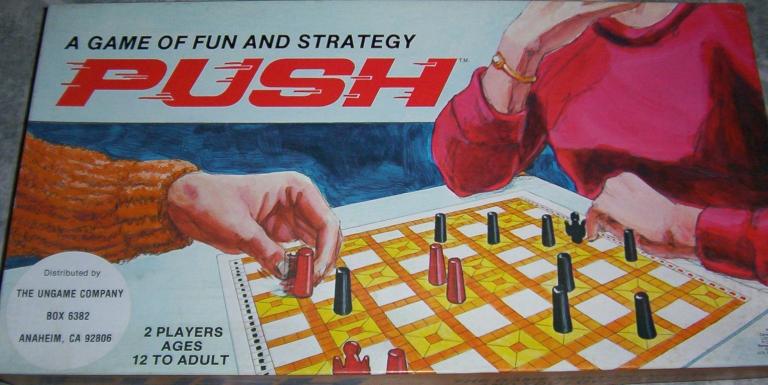Push

Push
The object of the game is to Push your Prince from its home position to one of the crowned squares on the opposite side of the board (the edge rows). This is achieved with the help of your eight Escort pieces.
On your turn, you move either your Prince (1, 2 or 3 steps) or an Escort (by its exact value: 3, 4, 5 or 6). Each step is horizontal, diagonal or vertical --but the board is odd. It is 33x33 with 64 3x3 tiles "punched out", some with a connected square remaining in the middle.
Jumps aren't allowed. A Push occurs when an Escort arrives short of another piece (Princes can't Push); what happens is that the Escort's remaining steps are transferred to the pushed piece --which may be an opposing piece or your own Prince. The pushed piece's move must be in a straight line, in the direction dictated by the collision. When the straight line isn't possible, deflection occurs as indicated in the rules. Compound pushes can occur, when a pushed piece in turn collides with another.
On your turn, you move either your Prince (1, 2 or 3 steps) or an Escort (by its exact value: 3, 4, 5 or 6). Each step is horizontal, diagonal or vertical --but the board is odd. It is 33x33 with 64 3x3 tiles "punched out", some with a connected square remaining in the middle.
Jumps aren't allowed. A Push occurs when an Escort arrives short of another piece (Princes can't Push); what happens is that the Escort's remaining steps are transferred to the pushed piece --which may be an opposing piece or your own Prince. The pushed piece's move must be in a straight line, in the direction dictated by the collision. When the straight line isn't possible, deflection occurs as indicated in the rules. Compound pushes can occur, when a pushed piece in turn collides with another.
Player Count
2
Playing Time
20
Age
12
Year Released
1979